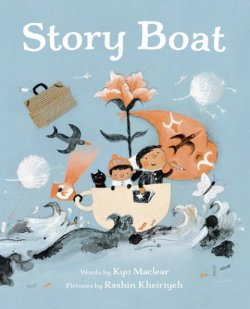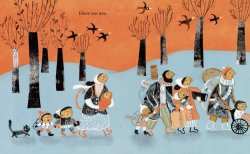Samantha Piede, United States

Review of Story Boat by Kyo Maclear, illustrated by Rashin Kheiriyeh (Montreal: Tundra Books, 2020). Also translated and published in Turkey (Albaraka Yayınları, 2020), Brazil (Companhia das Letras, 2021), and Germany (Zuckersüß Verlag, 2021).
When the protagonist in Kyo Maclear’s Story Boat (2020) opens the book with “Here we are,” it is unclear to readers where exactly “here” might be. The two-page spread, beautifully illustrated by Rashin Kheiriyeh, showcases a refugee family bundled for winter and trudging through a grey and orange landscape, but the sparse trees and circling crows give little in the way of national identification. Where exactly is “here?”
“Well, here is… Here is just here,” the protagonist clarifies. “Or here.”
Her answer, while poetically vague, speaks to the realities of refugees: in which “here,” in the spatial sense, is always changing. In many of the book’s illustrations, the protagonist’s family is depicted as on the move: packing up supplies, trundling through forests, adrift on a raft. “Sometimes,” the protagonist tells us, as she chases a butterfly in a temporary housing settlement, “it’s here just for a moment.” Maclear’s decision to avoid anchoring the book in any specific ‘heres’ allows the book to speak universally to refugees in crisis: that, regardless of where their journey begins, the move to safety is rarely short or straightforward. When safety must take precedence over familiarity, one develops, like the protagonist, a fleeting relationship with place.
For children especially, this disruption can be jarring. We all need something in our lives that feels stable and unmovable — perhaps why ‘home’ is so often linked to physical location. Yet, in this text, Maclear nudges readers towards other forms of stability. Early in the book, the protagonist reflects on drinking out of her favorite cup. “Every morning,” she relays, “as things keep changing, we sit wherever we are and sip, sip, sip, sippy, sip, sip. Ahhhh. From this cup.” It’s a simple gesture, but also an anchoring one. A cup is portable: easily carried and not limited to a particular location. In shaping a ritual around something that they can control, the protagonist and her brother create their own sense of foundation. She tells us, “And this cup is a home.”

Throughout the book, the protagonist finds new ‘heres’ not grounded in location. “Here,” she tells us, “is a blanket.” She treasures its warm familiarity where she can “snuggle and dream” during times when “the world feels not quite cozy, and everyone seems weary.” “Here” is also a solar-powered lamp by which she and her brother can “write and read and wonder, what will we be?” It’s notable how much space Maclear makes for dreams and for hope in this story.
“Here” is not even always tangible. The protagonist finds ‘heres’ in music (“a song that everyone can sing”) and in starlight (“a million sparkling stars”): phenomena she can carry with her without carrying anything at all. She even finds a “here” in the tale that she’s telling. The protagonist is often depicted with a notebook at her side, and, in several of the drawings, she is shown adding words and pictures that capture her dreams. “Every week,” she shares, “We dream and draw, make and play, search for treasure, find our way and grow, and wait and wait and wait, adding words to this story.” Maclear reminds us that one’s life, one’s own story, can also function as ‘here’.
It is tempting, in stories like these, to emphasize the pain of the refugee experience: the uncertainty, the loss of one’s ‘heres’. But Maclear takes a different tack, giving readers the tools to focus on hope and on wonder. Kheiriyeh’s gentle illustrations, replete with soft corals and creams, help sustain that warmth, conveying visually to readers that this space is a safe one for dreaming. This move may be intentional on her part; at the age of one, Kheiriyeh herself was a refugee, fleeing Iran with her family at the outset of the Iran-Iraq War. One wonders how her family too held onto hope.
Education is not averse to discussions of war as a theoretical phenomenon, but so rarely are we given tools to help us deal with it. Maclear does. This book provides students and educators with a model for what one can still hold onto when the rest of the world is changing. Teachers may be able to prompt students, in light of the book, to reflect on what they think a ‘home’ or a ‘here’ feels like – stable, certain, warm, safe – and what sorts of things in their lives, outside of ‘place,’ carry those same qualities: a memento, perhaps, or an activity or a ritual. By highlighting these possibilities in their own lives and hearing from others, students may recognize new ways to anchor themselves: an instrumental coping skill for anyone enduring a significant change.
Story Boat’s approach – emphasizing different ways we can create stability, especially when the world is tumultuous and uncertain – offers teachers and students something that is missing from much literature about crisis: a way to regain some control over one’s own story, a means to keep dreaming.
